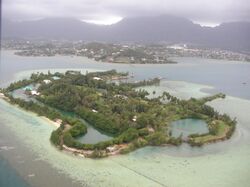Organization:Hawaiʻi Institute of Marine Biology
The Hawaiʻi Institute of Marine Biology (HIMB) is a marine biology laboratory located on the state-owned Coconut Island in Kāneʻohe Bay.
History
The institute was established in 1912. It began as a wooden structure on the shores of Waikiki and originally functioned in conjunction with the Waikiki Aquarium until 1919 when both operations became part of the University of Hawai‘i. In 1947 a group of wealthy oil tycoons, including Edwin W. Pauley, bought Coconut Island. Pauley donated a part of the island to the university for use as a marine laboratory for the study of the marine sciences.[1] In 1993, the Pauley family donated the remaining private part of Coconut Island for the construction of a world-class marine laboratory.[1]
In 2008, the institute was seeking 57 million dollars through state-issued bonds for the construction of a 24,000-square-foot (2,200 m2) marine research facility. The site is on the southeast side of the island. This is part of the master plan approved by the University of Hawaii's Board of Regents in 1998, which includes the addition of several research buildings, laboratories, and conference facilities. These will be funded on a case-by-case basis.[2] The intent is to turn Coconut Island into the world's premier coral reef research facility.[3]
Geography
Coconut Island is approximately 29 acres (120,000 m2), including 6 acres (24,000 m2) of enclosed lagoons used to keep organisms being studied in captivity. Surrounding it are 64 acres (260,000 m2) of coral reef, designated by the state of Hawai‘i as the Hawai‘i Marine Laboratory Refuge.[4] It is part of the University of Hawaii at Manoa.[5] It is the only research facility in the world built on a coral reef.[3]
The boundaries of the Hawaii Marine Laboratory Refuge surrounding the island start at the high-water mark on the island and go to twenty-five feet beyond the outer edges of the reefs, including sand and seawall shoreline, where coral and sand calcium carbonate reef flats are exposed at low tides. High coral and macro-algae flourish at shallow-depth zones while the deep habitats are characterized by sediment with low coral cover and colonized by slumping from upper reef zones. Within Kaneohe Bay are sheltered areas. Man-made impacts in the area include dredging, sewage release and freshwater flooding. The shores of the bay are characterized by coastal development.[6]
Habitat
The HIMB research facilities are used to explore deep-sea habitats where new species may be discovered and documented, as well as shallow reefs which are rich habitats likely to contain undiscovered species.[7]
Programs
Hawai‘i Coral Reef Assessment and Monitoring Program (CRAMP) is located at HIMB. It established a statewide network of more than 30 long-term coral reef monitoring sites with associated data collection systems. It went on to include rapid quantitative research and habitat mapping, which are tools new used to understand the ecology of the Hawaiian coral reefs in relation to surrounding geographic areas.[8]
One study of the HIMB research projects is on the effects of sound on dolphins.[9][10] Another is the study of chemicals in Enchanted Lake.[11]
In 2015, the institute was testing a new form of coral resistant to coral bleaching.[12] The institute also spoke publicly to argue in favor of banning sunscreens with chemicals, as they majorly contribute to coral bleaching.[13]
See also
- Hawaiian Islands Humpback Whale National Marine Sanctuary
- Hawaii Marine Laboratory Refuge
References
- ↑ 1.0 1.1 "HIMB - A Brief History of Coconut Island". http://www.soest.hawaii.edu/UHMEnergy/Campus%20Energy%20Projects/Coconut%20Island.html. Retrieved May 22, 2018.
- ↑ Kalani, Nanea (February 24, 2008). "$57 million in bonds would fund Coconut Island facility". https://www.bizjournals.com/pacific/stories/2008/02/25/focus3.html?jst=pn_pn_lk. Retrieved May 22, 2018.
- ↑ 3.0 3.1 Aguiar, Eloise (August 1, 2002). "Coconut Island impact study under way - The Honolulu Advertiser - Hawaii's Newspaper". The Honolulu Advertiser. http://the.honoluluadvertiser.com/article/2002/Aug/01/ln/ln34a.html. Retrieved May 22, 2018.
- ↑ "Coconut Island – Hawai‘i Marine Laboratory Refuge". Hawai'i Department of Land and Natural Resources. http://dlnr.hawaii.gov/dar/regulated-areas/coconut-island-hawaii-marine-laboratory-refuge/. Retrieved May 22, 2018.
- ↑ "Hawai‘i Institute of Marine Biology". www.hawaii.edu. http://www.himb.hawaii.edu/. Retrieved May 22, 2018.
- ↑ "Site Profile - Moku-o-loe Island (Coconut Island)". www3.mpa.gov. Archived from the original on December 20, 2007. https://web.archive.org/web/20071220172810/http://www3.mpa.gov/exploreinv/SiteProfile4.aspx?SiteID=HI22. Retrieved April 6, 2008.
- ↑ "National Marine Sanctuary Field Study". Archived from the original on August 12, 2007. https://web.archive.org/web/20070812215812/http://www.ngsednet.org/workshop_details.cfm?w_id=27. Retrieved April 6, 2008.
- ↑ "Hawaii Coral Reef Assessment & Monitoring Program (CRAMP) Home". cramp.wcc.hawaii.edu. http://cramp.wcc.hawaii.edu/.
- ↑ Kakesako, Gregg K. (September 3, 2007). "UH tests sonar on sea mammals". Honolulu Star-Bulletin. http://starbulletin.com/2007/09/03/news/story04.html.
- ↑ "NOAA Scientists Continue Nationwide Lecture Series on Human Noise Impact to Marine Mammals". June 4, 2004. http://www.publicaffairs.noaa.gov/releases2004/jun04/noaa04-r155.html.
- ↑ "Hawaii Institute of Marine Biology". Kailua Bay Advisory Council Contractor (KBAC). http://www.kbac-hi.org/contractors/himb.htm.
- ↑ "Scientists attempt to breed 'super coral' to save threatened reefs". November 5, 2015. https://www.theguardian.com/environment/2015/nov/05/scientists-attempt-to-breed-super-coral-to-save-threatened-reefs.
- ↑ Gregory, Katherine (May 4, 2018). "Hawaii bans sunscreens with chemicals that damage coral reefs, but Australia reluctant to follow". http://www.radioaustralia.net.au/international/2018-05-04/hawaii-bans-sunscreens-with-chemicals-that-damage-coral-reefs-but-australia-reluctant-to-follow/1754154.
External links
[ ⚑ ] 21°25′58″N 157°47′16″W / 21.4327°N 157.7877°W


